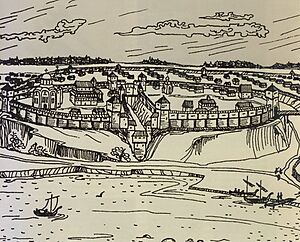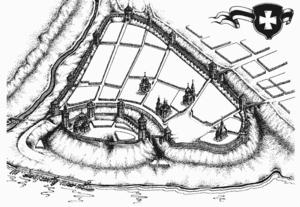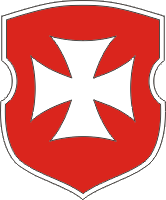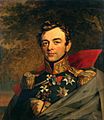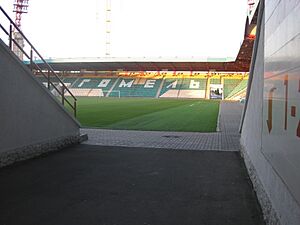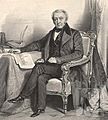Gomel facts for kids
Quick facts for kids
Gomel
Гомель
Homyel
|
|||
|---|---|---|---|
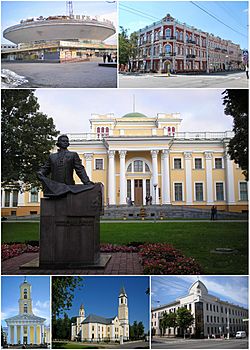
Top: Gomel State Circus Arena (left) and Gomel State Post Office heritage building (right)
Center: Rumyantsev-Paskevich Palace and statue of Nikolay Rumyantsev Bottom: Saint Peters and Pavel Orthodox Church, Gomel Nativity of Virgin Mary Church, and Gomel City Council (left to right) |
|||
|
|||
| Country | Belarus | ||
| Region | Gomel Region | ||
| First mentioned | 1142 | ||
| Area | |||
| • Total | 139.77 km2 (53.97 sq mi) | ||
| Elevation | 138 m (453 ft) | ||
| Population
(2024)
|
|||
| • Total | 501,102 | ||
| • Density | 3,585.19/km2 (9,285.6/sq mi) | ||
| Time zone | UTC+3 (MSK) | ||
| Postal code |
246xx, 247xxx
|
||
| Area code(s) | +375 232(2) | ||
| License plate | 3 | ||
Gomel (also spelled Homyel) is a large city in Belarus. It is the main city of the Gomel Region. As of 2024, Gomel is the second-largest city in Belarus, with over 500,000 people living there.
Contents
What's in a Name?
The name Gomel likely comes from a small stream called Homeyuk. This stream flowed into the Sozh River near where the first settlement was built. Many Belarusian cities are named after rivers or streams, like Polotsk from the Palata River.
The city's name first appeared in 1142 as "Gomy." Over time, its name changed to Hom', Homye, Homiy, Homey, or Homyi. The name "Gomel" as we know it today has been used since the 16th or 17th centuries.
A Look Back: Gomel's History
Early Days: Kievan Rus'
Gomel was founded a very long time ago, around the year 1000 AD. It was built on the banks of the Sozh River and the Homeyuk stream. The high riverbank made it a naturally strong place for a settlement.
For a while, Gomel was the capital of its own small principality. Later, it became part of the Principality of Chernigov. The city is first mentioned in old writings in 1142. It was an important trading and craft center. Sadly, the city was heavily damaged by Mongol-Tatar attacks in the 1200s.
Changes of Power: Lithuania and Poland
In 1335, Gomel became part of the Great Duchy of Lithuania. Over the next centuries, different princes and rulers controlled the city. There were many battles as Lithuania tried to keep control of Gomel.
In 1535, Polish and Lithuanian forces took the city back from Moscow. Gomel then became part of the Polish–Lithuanian Commonwealth in 1569. This meant the city was often caught in conflicts between Cossacks, Russia, and the Commonwealth.
In 1560, Gomel got its first coat of arms. The city faced many attacks and sieges during this time. In 1670, Gomel was granted Magdeburg rights, which gave it more self-governance. However, the constant fighting caused a lot of damage, and the city's population and crafts suffered.
Under the Russian Empire
-
Ivan Fyodorovich Paskevich (1782–1856)
Gomel became part of the Russian Empire in 1772. Empress Catherine II gave Gomel to a military leader named Pyotr Rumyantsev.
During this time, Gomel grew very quickly. More people moved there, and the city's buildings and industries expanded. This growth was especially fast after railways were built in the late 1800s.
Important buildings like the Peter and Paul Cathedral were built. Nikolay Rumyantsev (Pyotr's son) opened schools, factories, and other important services. Later, the city was sold to Prince Ivan Paskevich, who created a beautiful English garden around the Gomel Palace.
By 1913, Gomel was a big industrial city with over 100,000 people. It was known for metalworking and timber.
War and Soviet Times
During World War I, German forces occupied Gomel in 1918. After the war, in 1919, the Red Army took control. There was a large uprising against the Bolsheviks in Gomel that year, but it was stopped.
Gomel became part of the Russian Soviet Federative Socialist Republic and later the Byelorussian SSR in 1926. Industries and transportation were rebuilt and expanded. By 1940, the city had many factories.
World War II and Rebuilding
World War II brought terrible destruction to Gomel. The city was under Nazi occupation from 1941 to 1943. When it was finally freed, about 80% of the city was destroyed. The population dropped from 144,000 to less than 15,000 people.
After the war, Gomel was quickly rebuilt. Many new buildings were constructed in the Stalinist style. By 1950, most of the city's businesses were working again.
Chernobyl Disaster
On April 26, 1986, the Chernobyl Nuclear Power Plant had a terrible accident. Gomel was affected by radioactive contamination from this disaster. Today, there is a special scientific center in Gomel that studies and helps with the effects of Chernobyl. Life is now possible in these areas, but people still follow special rules about what they eat.
Recent History
In 1990, Belarus declared its independence, and Gomel became a city in the new country of Belarus. More recently, during the Russian invasion of Ukraine, Gomel became a base for Russian forces.
How Many People Live Here?
In 2013, Gomel's population was over 515,000 people. This shows that the city is growing again after a period when its population decreased.
| Historical population | |||||||||||||||||||||||||||||||||||||||||||||||||||||||
|---|---|---|---|---|---|---|---|---|---|---|---|---|---|---|---|---|---|---|---|---|---|---|---|---|---|---|---|---|---|---|---|---|---|---|---|---|---|---|---|---|---|---|---|---|---|---|---|---|---|---|---|---|---|---|---|
|
|
||||||||||||||||||||||||||||||||||||||||||||||||||||||
Jewish Community
After Gomel became part of the Russian Empire, many Jewish people moved there. By 1897, over half of Gomel's population was Jewish. However, in 1903, there was a violent attack against the Jewish community.
Before World War II, many Jews left the city. Still, thousands of Gomel Jews were victims of the Holocaust. In the late 1980s and early 1990s, many more Jewish people emigrated from Gomel. However, those who remained have worked to rebuild Jewish community centers in the city.
Where is Gomel?
Gomel is in the southeastern part of Belarus. It sits on the right bank of the Sozh River. It is about 302 kilometers (188 miles) southeast of Minsk, the capital of Belarus.
The land around Gomel is mostly flat. The right bank of the river is a gently sloping plain. The left bank is a low, flat area. The highest point in Gomel is 144 meters (472 feet) above sea level. The lowest point is 115 meters (377 feet) at the Sozh River. The Novobelitskiy district, on the left bank, is generally lower than the rest of the city.
The Sozh River has many kilometers of beaches on its left bank.
Gomel's Climate
Gomel has a climate with warm summers and cold winters. This is because warm air often comes from the Atlantic Ocean. The highest temperature ever recorded in Belarus was in Gomel on August 7, 2010, when it reached 38.9°C (102°F).
| Climate data for Gomel (1991–2020, extremes 1927–present) | |||||||||||||
|---|---|---|---|---|---|---|---|---|---|---|---|---|---|
| Month | Jan | Feb | Mar | Apr | May | Jun | Jul | Aug | Sep | Oct | Nov | Dec | Year |
| Record high °C (°F) | 10.0 (50.0) |
15.8 (60.4) |
24.2 (75.6) |
29.3 (84.7) |
32.5 (90.5) |
36.2 (97.2) |
37.9 (100.2) |
38.9 (102.0) |
34.9 (94.8) |
27.5 (81.5) |
18.0 (64.4) |
11.6 (52.9) |
38.9 (102.0) |
| Mean daily maximum °C (°F) | −1.8 (28.8) |
−0.5 (31.1) |
5.3 (41.5) |
14.1 (57.4) |
20.5 (68.9) |
23.9 (75.0) |
25.9 (78.6) |
25.1 (77.2) |
19.0 (66.2) |
11.5 (52.7) |
4.0 (39.2) |
−0.5 (31.1) |
12.2 (54.0) |
| Daily mean °C (°F) | −4.2 (24.4) |
−3.5 (25.7) |
1.3 (34.3) |
9.0 (48.2) |
15.0 (59.0) |
18.6 (65.5) |
20.4 (68.7) |
19.3 (66.7) |
13.7 (56.7) |
7.4 (45.3) |
1.6 (34.9) |
−2.7 (27.1) |
8.0 (46.4) |
| Mean daily minimum °C (°F) | −6.5 (20.3) |
−6.2 (20.8) |
−2.2 (28.0) |
4.3 (39.7) |
9.8 (49.6) |
13.5 (56.3) |
15.4 (59.7) |
14.2 (57.6) |
9.2 (48.6) |
4.0 (39.2) |
−0.4 (31.3) |
−4.8 (23.4) |
4.2 (39.6) |
| Record low °C (°F) | −35.0 (−31.0) |
−35.1 (−31.2) |
−33.7 (−28.7) |
−13.6 (7.5) |
−2.5 (27.5) |
−0.2 (31.6) |
6.0 (42.8) |
1.2 (34.2) |
−3.2 (26.2) |
−12.0 (10.4) |
−21.7 (−7.1) |
−30.8 (−23.4) |
−35.1 (−31.2) |
| Average precipitation mm (inches) | 36 (1.4) |
35 (1.4) |
36 (1.4) |
35 (1.4) |
64 (2.5) |
73 (2.9) |
100 (3.9) |
56 (2.2) |
52 (2.0) |
58 (2.3) |
45 (1.8) |
42 (1.7) |
632 (24.9) |
| Average extreme snow depth cm (inches) | 8 (3.1) |
9 (3.5) |
6 (2.4) |
0 (0) |
0 (0) |
0 (0) |
0 (0) |
0 (0) |
0 (0) |
0 (0) |
2 (0.8) |
5 (2.0) |
9 (3.5) |
| Average rainy days | 8 | 7 | 10 | 13 | 14 | 16 | 14 | 12 | 14 | 14 | 13 | 9 | 144 |
| Average snowy days | 18 | 17 | 10 | 2 | 0.1 | 0 | 0 | 0 | 0.03 | 2 | 10 | 16 | 75 |
| Average relative humidity (%) | 86 | 83 | 77 | 66 | 64 | 69 | 70 | 71 | 77 | 81 | 87 | 88 | 77 |
| Mean monthly sunshine hours | 43.3 | 72.5 | 143.9 | 201.3 | 272.6 | 293.7 | 297.9 | 269.9 | 194.4 | 119.9 | 47.0 | 32.1 | 1,988.5 |
| Percent possible sunshine | 19 | 25 | 37 | 42 | 54 | 54 | 54 | 55 | 45 | 35 | 17 | 13 | 41 |
| Source 1: Pogoda.ru.net | |||||||||||||
| Source 2: NOAA, Belarus Department of Hydrometeorology (percent sun 1957–1960 and 1973–2000) | |||||||||||||
Getting Around Gomel

Gomel has a large public transportation system. It includes over 1,000 buses and trolleybuses. In 2006, over 210 million passenger rides were taken! Taxis are also available all day and night.
The city is an important railway hub. It sits between Minsk and Kyiv, connecting to the large railway networks of Russia and Ukraine.
Gomel has a trolleybus network with 23 routes. It opened in 1962. There are also more than 60 bus routes and many express routes. For smaller groups, there are 24 minibus lines.
Gomel Airport is located about 8 kilometers (5 miles) northeast of the city.
Sports in Gomel
Gomel has many sports facilities. These include eight stadiums and an Ice Palace with two ice rinks. People enjoy hockey, track and field, and football here. HK Gomel is the city's professional hockey team. FC Gomel is the local football club, and they play at the Central Stadium. Gomel also hosts international sports events, like the "Bells of Chernobyl" competition.
The city has many "Olympic Reserve Schools," which are sports schools. These schools train young athletes. For example, one school has trained 97 World and European champions and two Olympic athletes! Gomel State College of Olympic Reserve trains coaches. Many of its graduates have participated in the Olympics and other major championships. Gomel also competes in the Deaflympics, winning several medals.
Learning in Gomel
Gomel has important universities like Pavel Sukhoi State Technical University of Gomel and Gomel State Medical University. These universities attract students from all over the world. Gomel State Medical University even offers classes in English. Many famous scientists teach at these schools.
Culture and Sights
Gomel has an 800-year history, but only a few old sights remain. Most of the older buildings that are still standing are from the 1700s and 1800s. Many of the city's architectural landmarks were built in the 1950s. Most of these are in the city center.
The Ferris Wheel and Ferris Tower are popular attractions. They are located in a park near the palace complex. Since Gomel is a flat city, you can get great views of the whole city from the top of the wheel and tower!
Famous People from Gomel
Many notable people have come from Gomel, including:
- Igor Avrunin (1957–2020), an athlete
- Paluta Badunova (1885–1938), an important figure in the Belarusian independence movement
- Yuri Foreman (born 1980), the first Israeli boxing world champion
- Leonid Geishtor (born 1936), an Olympic and world champion canoer
- Andrei Gromyko (1909–1989), a Soviet Minister of Foreign Affairs
- Mikhail Grabovski (born 1984), a retired professional ice hockey player
- Lev Vygotsky (1896–1934), a famous psychologist
Sister Cities
Gomel has "sister city" relationships with many cities around the world. These partnerships help build friendships and cultural ties.
 Anapa, Russia
Anapa, Russia Armavir, Russia
Armavir, Russia Bryansk, Russia
Bryansk, Russia Burgas, Bulgaria
Burgas, Bulgaria Chernihiv, Ukraine
Chernihiv, Ukraine Cheryomushki (Moscow), Russia
Cheryomushki (Moscow), Russia Clermont-Ferrand, France
Clermont-Ferrand, France Dnipro, Ukraine
Dnipro, Ukraine Donetsk, Ukraine
Donetsk, Ukraine Fort Myers, United States
Fort Myers, United States Harbin, China
Harbin, China Huai'an, China
Huai'an, China Kaliningrad, Russia
Kaliningrad, Russia Krasnoselsky (Saint Petersburg), Russia
Krasnoselsky (Saint Petersburg), Russia Kurgan, Russia
Kurgan, Russia Kursk, Russia
Kursk, Russia Kutaisi, Georgia
Kutaisi, Georgia Liepāja, Latvia
Liepāja, Latvia Magnitogorsk, Russia
Magnitogorsk, Russia Novi Sad, Serbia
Novi Sad, Serbia Omsk, Russia
Omsk, Russia Protvino, Russia
Protvino, Russia Rostov-on-Don, Russia
Rostov-on-Don, Russia Samara, Russia
Samara, Russia Solomianskyi (Kyiv), Ukraine
Solomianskyi (Kyiv), Ukraine Ulyanovsk, Russia
Ulyanovsk, Russia Vasileostrovsky (Saint Petersburg), Russia
Vasileostrovsky (Saint Petersburg), Russia Voronezh, Russia
Voronezh, Russia
Some cities have ended their partnerships with Gomel. For example, Radom in Poland and Aberdeen in the United Kingdom ended their ties in 2022. This was due to Belarus's involvement in the 2022 Russian invasion of Ukraine.
Images for kids
See also
 In Spanish: Gómel para niños
In Spanish: Gómel para niños






